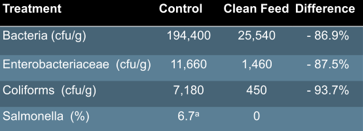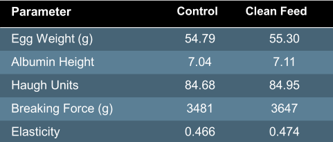- Posted by Jose Ramirez
How Clean Feed Assists in Producing Safer Eggs
Salmonella and Eggs
Do you know that the outer shell of the eggs can be contaminated by the penetration of bacteria through one of approximately 8,000 pores present in the eggshell? Salmonella may come from the colonized gut, contaminated feces during or after laying or direct contamination of the yolk, albumen, eggshell membranes, or eggshells before laying, or contact with contaminated surface.
Control measures for Salmonella includes, examining eggs for cracks, washing and disinfecting eggs, however, these measures have not eliminated the incidence of having eggs contaminated with Salmonella (Braden, 2006). In addition, Salmonella have been recovered from raw and pasteurized egg products (White et al., 2007).
Salmonella in Feed
Feed and feed ingredients are considered fomites for microbial pathogens such as mold, bacteria and viruses, causing concern for food safety, animal welfare and production efficiency. Salmonella has been recognized as one the pathogens present in feeds. A feed safety study performed by Shirota et al. (2000), found that 58.5% of the serotypes in the egg same as found in feed. A positive association was observed between the incidence of Salmonella in the feed and in the eggs. In the months where S. enteritidis was more frequently found in feed, it also occurred more frequently in eggs (Shirota et al., 2001).
Another study, (Jenson & Rosales, 2002), found that 80% of the serotypes of Salmonella from breeder feed were found weeks later in the breeding flock or their offspring, indicating Salmonella positive feed led to contaminated eggs. More recently, with the advent of CRISPR technology, Shariat (2020) isolated 7 serotypes of Salmonella in feed samples and 5 of them have been associated with human illness, and among them are serovars related to past egg and poultry products outbreaks.
Salmonella Control in Feed
The utilization of an effective feed sanitizer is seen as a strategy to mitigate the risk of Salmonella contaminating the eggs thru feed consumption, as its application in feed has resulted in reduced colonization of Salmonella in breeding flocks (Primm et al, 1997), and in layers, a reduction in eggshell contamination by bacteria, Enterobacteriaceae and Salmonella has also been reported.

The same research shows clean feed improve eggshell quality due to increase in breaking force and elasticity, which reduces the incidences rates of checks and cracked eggs, reducing the ability of bacteria to reach the interior of the eggs.

Integrating an effective feed sanitizer program to reduce the risk of having contaminated eggs reaching the processing facilities and going into the market is paramount.
For more information on the benefits of clean feed on eggs and how to implement an effective program, visit our website .

